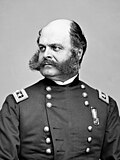Military
Ambrose Burnside was an arms manufacturer, politician, and general in the Rhode Island state militia and was an influential army officer. He rose to command of the Army of the Potomac before his disastrous defeat at the Battle of Fredericksburg in December 1862. He later commanded the Department of the Ohio as well as the IX Corps. His field duty ended during the siege of Petersburg with the Battle of the Crater, another fiasco for which he took the blame. [5]
Major General Silas Casey of East Greenwich, Rhode Island led a division in the Army of the Potomac during the 1862 Peninsula Campaign that suffered heavy losses at the Battle of Seven Pines facing George Pickett's brigade. He wrote the three-volume System of Infantry Tactics published in August 1862, and Infantry Tactics for Colored Troops published in March 1863. These manuals were used by both sides during the Civil War. [6] [7]
Isaac P. Rodman commanded the 3rd Division of the IX Corps during the Maryland Campaign. He led the efforts to take Turner's Gap during the Battle of South Mountain in September 1862. A few days later, he was mortally wounded at the Battle of Antietam. [8] Brigadier General Richard Arnold was the son of Rhode Island Governor Lemuel Arnold and the Chief of Artillery for the Army of the Gulf. His guns helped force the surrender of Mobile, Alabama and Port Hudson, Louisiana. [9] [10]
Zenas Bliss of Johnston, Rhode Island led an infantry brigade in the IX Corps during the siege of Petersburg. After the war, he received the Medal of Honor for gallantry at Fredericksburg. [11] George S. Greene of Apponaug, Rhode Island spearheaded the defense of the Union right flank at Culp's Hill during the Battle of Gettysburg in July 1863. At the very end of the war, he was in command of the 3rd Brigade in Absalom Baird's 3rd Division, XIV Corps, and participated in the capture of Raleigh, North Carolina and the pursuit of General Joseph E. Johnston's army until its surrender. [12]
Brigadier General Thomas W. Sherman of Newport, Rhode Island commanded the defenses of New Orleans, Louisiana before taking command of a division in Major General Nathaniel P. Banks's army, which he led into action at the siege of Port Hudson. He lost a leg during this combat and was consigned to desk duty for the rest of the war. [13] [14] Frank Wheaton of Providence led a brigade and then a division in the Army of the Potomac, seeing action in the Overland Campaign and the siege of Petersburg. His men were hurried by train to Washington, D.C. in time to help repel Jubal Early's raid on the capital in the summer of 1864. [14] [15]
William Rogers Taylor was Fleet Captain of the South Atlantic Blockading Squadron in 1863. He participated in attacks on the Confederate fortifications protecting Charleston, South Carolina. He then commanded the steam sloop Juniata during 1864-65 and took part in the operations that led to the capture of Fort Fisher, North Carolina. [16]










